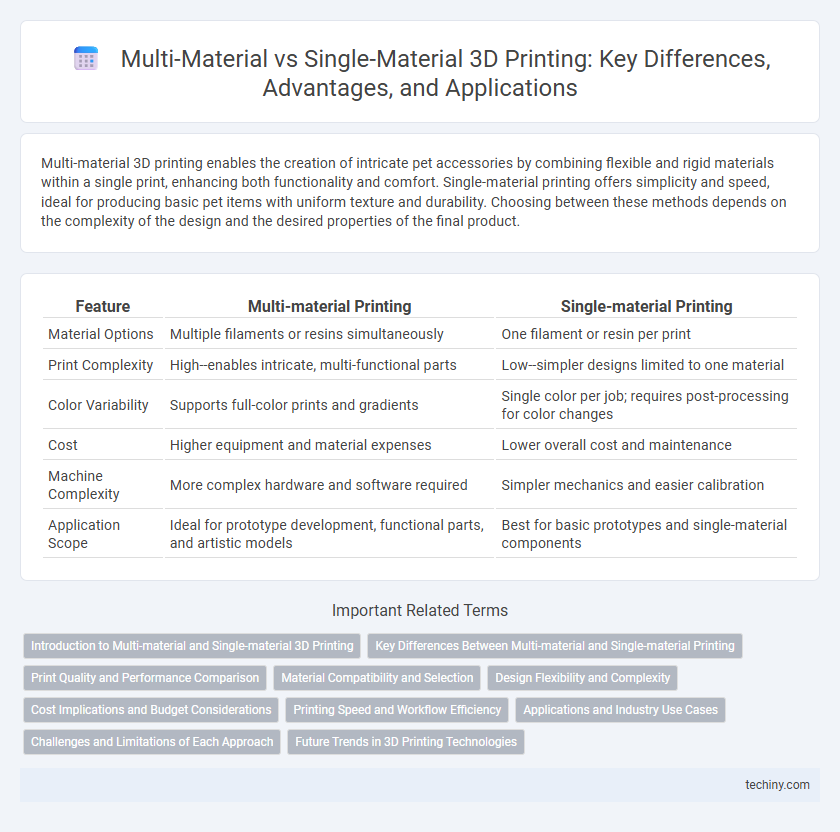Multi-material 3D printing enables the creation of intricate pet accessories by combining flexible and rigid materials within a single print, enhancing both functionality and comfort. Single-material printing offers simplicity and speed, ideal for producing basic pet items with uniform texture and durability. Choosing between these methods depends on the complexity of the design and the desired properties of the final product.
Table of Comparison
| Feature | Multi-material Printing | Single-material Printing |
|---|---|---|
| Material Options | Multiple filaments or resins simultaneously | One filament or resin per print |
| Print Complexity | High--enables intricate, multi-functional parts | Low--simpler designs limited to one material |
| Color Variability | Supports full-color prints and gradients | Single color per job; requires post-processing for color changes |
| Cost | Higher equipment and material expenses | Lower overall cost and maintenance |
| Machine Complexity | More complex hardware and software required | Simpler mechanics and easier calibration |
| Application Scope | Ideal for prototype development, functional parts, and artistic models | Best for basic prototypes and single-material components |
Introduction to Multi-material and Single-material 3D Printing
Multi-material 3D printing enables the creation of complex objects by combining different materials with varying properties such as flexibility, color, and strength within a single print. Single-material 3D printing uses one filament or resin type, often resulting in uniform mechanical and aesthetic characteristics throughout the printed object. Advancements in multi-material printing technology enhance functional prototyping and product customization compared to traditional single-material methods.
Key Differences Between Multi-material and Single-material Printing
Multi-material printing allows the simultaneous use of different materials within a single print, enabling complex structures with varied properties such as flexibility, color, and strength. Single-material printing typically involves one type of filament or resin, limiting the final model to uniform characteristics but simplifying the printing process. The key differences include material versatility, design complexity, and mechanical performance, with multi-material printing offering enhanced functionality at the cost of increased printer complexity and calibration requirements.
Print Quality and Performance Comparison
Multi-material printing enables the combination of diverse materials within a single print, resulting in enhanced mechanical properties, improved surface finish, and complex functional integration compared to single-material printing. Single-material printing often faces limitations in achieving variable stiffness, color gradients, or multi-functional parts, reducing overall performance potential. Print quality in multi-material printing benefits from the precise deposition of compatible materials, leading to higher resolution and durability in finished components.
Material Compatibility and Selection
Multi-material printing enables the use of diverse materials with varying mechanical and thermal properties in a single process, expanding design possibilities and functionality beyond the limits of single-material printing. Material compatibility is critical; incompatible materials can cause adhesion failures, print defects, and mechanical weaknesses, whereas carefully selected compatible materials improve part integrity and performance. Advanced printers with precise temperature and extrusion controls facilitate seamless integration of materials like thermoplastics, elastomers, and composites, optimizing the selection for tailored applications.
Design Flexibility and Complexity
Multi-material printing significantly enhances design flexibility by enabling the integration of diverse materials with varying properties, allowing for complex structures and functional gradients within a single print. Single-material printing limits the design to uniform material characteristics, restricting the complexity and multifunctionality achievable in the final product. Advanced multi-material 3D printers facilitate intricate geometries and tailored performance, critical for applications in aerospace, medical devices, and consumer products.
Cost Implications and Budget Considerations
Multi-material 3D printing typically incurs higher costs due to the need for specialized printers, multiple filament types, and increased maintenance, which can strain budgets. Single-material printing offers a more cost-effective solution with simpler equipment and lower material expenses, making it suitable for projects with tight financial constraints. Evaluating production volume and part complexity helps determine whether the investment in multi-material printing justifies the increased budget requirements.
Printing Speed and Workflow Efficiency
Multi-material printing offers enhanced workflow efficiency by combining different materials in a single process, reducing the need for multiple print jobs and post-processing steps, which significantly speeds up project turnaround times. Single-material printing generally operates faster per layer due to simpler mechanisms, but the overall production time increases when multiple materials are required through separate runs. Optimizing print speed and workflow efficiency in multi-material 3D printing relies on advanced printer technology that manages material transitions seamlessly without compromising print quality.
Applications and Industry Use Cases
Multi-material 3D printing enhances product functionality by enabling the combination of diverse materials such as polymers, metals, and ceramics within a single print, making it ideal for complex aerospace components, customized medical implants, and integrated electronics. Single-material printing remains prevalent in prototyping, automotive parts production, and consumer goods where uniform material properties meet specific strength and durability requirements. Industries such as healthcare, aerospace, and electronics benefit from multi-material printing for tailored, multi-functional solutions, while manufacturing sectors often rely on single-material printing for cost-effective, high-volume production.
Challenges and Limitations of Each Approach
Multi-material printing faces challenges in material compatibility, increased printer complexity, and precise calibration to ensure seamless bonding between different substances. Single-material printing offers simplicity and reliability but limits product functionality and design versatility due to restricted material properties. Both approaches encounter constraints in speed, cost, and post-processing requirements impacting industrial scalability.
Future Trends in 3D Printing Technologies
Multi-material printing advances the capabilities of 3D printing by enabling the integration of diverse substances such as plastics, metals, and ceramics within a single object, expanding functional applications in aerospace, healthcare, and automotive industries. Future trends highlight the development of smarter printers equipped with AI-driven material blending, increasing precision and reducing post-processing efforts compared to single-material printing. Enhancements in material science, including responsive and bio-compatible materials, are set to revolutionize manufacturing processes by offering greater customization and multi-functionality in printed objects.
Multi-material Printing vs Single-material Printing Infographic

 techiny.com
techiny.com